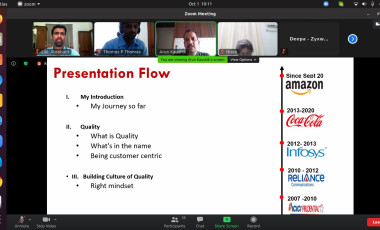Some Live Examples of Quality Change: Talk by Arun Kaushik of Amazon
Zyxware Technologies invited Mr Arun Kaushik of Amazon to give a talk on “ Quality & Quality Culture” as part of our ‘Utthaan’ Initiative. This article is one of a five-part series based on the talk Mr Kaushik gave to Zyxware Technologies.
Disclaimer: The content presented here is NOT a verbatim representation of Mr Arun Kaushik’s talk. While trying to keep the published content here as close as possible to Mr Kaushik’s talk, we disclaim and do not hold the speaker responsible for any unintended misrepresentation here.
Here are some actual examples where the quality methodology helped organisations deliver their business objectives.
Organisations deploy primarily third-party trucks while delivering products from the manufacturing plants to the respective distributions or from fulfilment points to the city delivery centres. So broadly, the organisation measures the logistic cost and all these pieces but don't look at the processes. Cost is always projected based on inflation, fuel prices, costing, and everything added to the business plans.
This case study is where a beverage company has to deliver a product using 300 trucks into Mumbai. The per-unit cost of segments was calculated by estimating targets based on the historical trends, cost inflation, fuel price et cetera. Although it was a business matrix – there was never a study on how the cost came about.
Remember, these are organisations that adopt zero-based costing, so there were many methodologies. But there was a gap in terms of how we understood the processes.
When we went about the project, we got some stark revelations about how the entire process was structured. We did a complete lean mapping in terms of how the plants were structured and their capacities. The documentation itself did make the process delayed.
We found how market-related or third party related constraints impacted the process of exit from one location to another. While doing this, we studied lots of processes and streamlined them. We could optimise the inventory process, and ultimately, we could deliver a saving of around 80 Million.
Now how did these savings come about? Due to the project, the turnaround time of the third party trucks, which was approximately 72 hours, could be reduced to 36 hours. We did a mapping on how the trucks were getting tracked and whether they were GPS enabled or not. We tweaked the entire process to ensure that these costs were minimal and turnaround time minimal.
So this was a typical Lean six sigma project of understanding the process and gaps- and most importantly, we linked it to the business objective. While the project was doing nothing commercially and was entirely process-based, it could reduce the cost by 80 million.
A similar example would be another company having almost 10,000 trucks plying on the roads in India every day. Out of every 1000, 100 are moving empty. These 100 trucks were not carrying any consignment just because they were planned and not cancelled.
One hundred trucks going out of the premises empty!
Is it a cost the organisation should bear?
No.
Again, we did mapping to determine why trucks were leaving these centres without consignment and why they were not getting cancelled. What were the loading practises and the reasons for the multi-connected nodes? It boiled down to understanding the processes.
It is done by the quality team, the excellence team, the operational excellence team, and that's how quality is directly related to the business objective. It is an example of logistic initiatives.
In another example, we delivered more than 100 Million savings as we generated more sales from the company assets deployed in the market. For a chilled beverage company in India, we placed a refrigerator in more than 70% of outlets to serve the beverage chilled. There are lots of back end processes behind how we can generate sales from these coolers. We have to monitor
- how we are going to place the coolers in new outlets,
- whether we have the coolers working,
- how many are working and what is the defect rate,
- how do we track lead time, request onboarding etc.,
- how we are nurturing them,
- the service maintenance schedule, service rate, SLA (Service Level Agreement) etc.,
- what kind of brands can be put in, SKU (Stock Keeping Unit)'s availability,
- what are the planograms of brand placement, new product placement,
- how we are doing the exit to avoid the losses ( when the cooler gets lost).
That is the entire life cycle management for the assets.
In a typical MNC environment, every day, some things are lost. Most importantly, a company asset in a retail outlet is a competitive advantage. So the backend processes related to what kind of sales we are doing through these assets is critical.
Many sub-processes are going behind this one piece, and they have financial implications, as in this case: Savings of INR 100 Million.
(Talk by Arun Kaushik paraphrased by Nisha Oommen)



